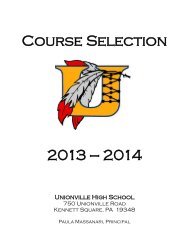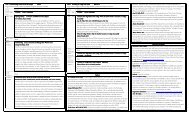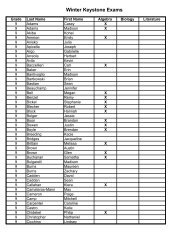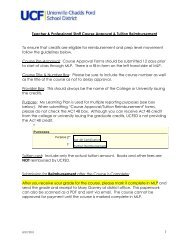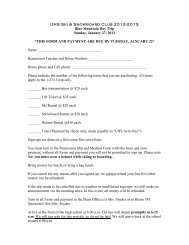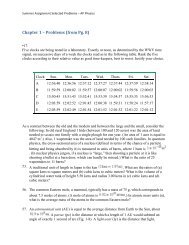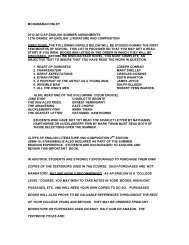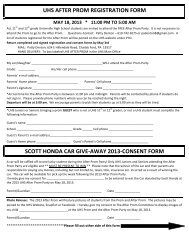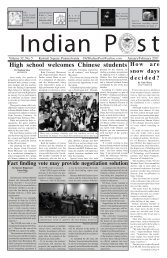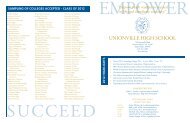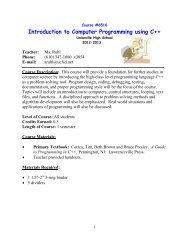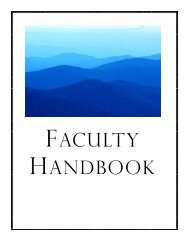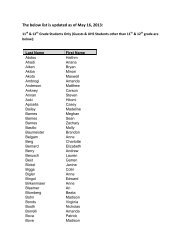technology and engineeringTEACHER - Unionville High School ...
technology and engineeringTEACHER - Unionville High School ...
technology and engineeringTEACHER - Unionville High School ...
You also want an ePaper? Increase the reach of your titles
YUMPU automatically turns print PDFs into web optimized ePapers that Google loves.
VOLUME 72 ISSUE 5<br />
<strong>technology</strong> <strong>and</strong><br />
engineering TEACHER<br />
February 2013<br />
COLUMBUS<br />
CONFERENCE<br />
EXHIBITORS<br />
stem<br />
BRINGING<br />
STEM TO LIFE<br />
urban<br />
education<br />
INTEGRATIVE<br />
STEM ED AT<br />
VIRGINIA TECH
BRINGING STEM TO LIFE<br />
BRINGING<br />
Our high school students have been warned repeatedly that they must prepare<br />
<br />
stemTO LIFE<br />
BY MIKE BERKEIHISER AND DORI RAY<br />
Have you been looking for quality STEM activities for your <strong>technology</strong> <strong>and</strong> engineering<br />
program? Would you like to expose a wider variety of students to your curriculum? Do<br />
you strive to involve your Technology <strong>and</strong> Engineering Education Department in inter-<br />
disciplinary activities with other academic subject areas?<br />
The interdisciplinary approach that STEM projects inspire in<br />
both teachers <strong>and</strong> students “brings to light a larger picture that<br />
<br />
been shown to increase undergraduate persistence in STEM”<br />
(diverseeducation.com).<br />
Our high school students have been warned<br />
repeatedly that they must prepare themselves<br />
<br />
exist. These warnings have resulted in an<br />
increased emphasis on cooperative problem<br />
solving, innovative solution writing, <strong>and</strong> technological<br />
skill acquisition across the curricula of<br />
secondary schools. By pairing mathematics <strong>and</strong><br />
<strong>technology</strong> classes together in unique ways,<br />
<br />
jobs may dem<strong>and</strong> (Figure 1).<br />
At <strong>Unionville</strong> <strong>High</strong> <strong>School</strong> in Kennett Square,<br />
PA, calculus teacher Dori Ray requires her<br />
advanced placement calculus students to build<br />
three-dimensional solids of known cross-section<br />
out of layers of h<strong>and</strong>-cut foam. The process<br />
is very similar to the process <strong>technology</strong> <strong>and</strong><br />
engineering teachers have used for years to make 3-D models<br />
from sheet goods using laser cutters, vinyl sign cutters, CNC<br />
routers, <strong>and</strong> manual processes. Each slice of a thin material is<br />
<br />
the result is a functional 3-D model (Figure 2).<br />
Figure 1: Engineering CAD <strong>and</strong> AP Calculus students draw a parabola using AutoCAD.<br />
February 2013 <strong>technology</strong> <strong>and</strong> engineering teacher 21
BRINGING STEM TO LIFE<br />
Figure 2: <br />
This year, Ms. Ray’s students completed their models by h<strong>and</strong><br />
using graphing calculators, spreadsheets, scissors, <strong>and</strong> glue.<br />
They converted coordinate units to centimeters, determined<br />
<br />
functions, <strong>and</strong> painstakingly cut each shape to build their mod-<br />
<br />
<strong>technology</strong> <strong>and</strong> engineering teacher at UHS. The two teachers<br />
then created a new <strong>and</strong> exciting stage of the project in which the<br />
calculus students could communicate their sophisticated scaling,<br />
slicing, <strong>and</strong> cutting needs to Mr. Berkeihiser’s engineering CAD<br />
drafting students who would exp<strong>and</strong> the task to one involving<br />
AutoCAD <strong>and</strong> a laser cutter (Figure 3). Calculus students <strong>and</strong><br />
Figure 3: <br />
22 <strong>technology</strong> <strong>and</strong> engineering teacher February 2013<br />
engineering CAD students were paired into teams so they could<br />
better use each student’s unique background <strong>and</strong> skills. A few<br />
of Mr. Berkeihiser’s current <strong>and</strong> past engineering CAD students<br />
were also in Ms. Ray’s calculus class <strong>and</strong> proved tremendously<br />
valuable in translating the task between calculus terminology<br />
<strong>and</strong> CAD terminology <strong>and</strong> back to calculus terms when it came<br />
time to evaluate the volumes of the resulting models.<br />
<br />
interrupted by a few absences which, fortuitously, provided Ms.<br />
Ray with an additional learning opportunity. Because some<br />
calculus students were absent, there were extra engineering<br />
CAD students without partners, <strong>and</strong> Ms. Ray, knowing that a<br />
solid model of a known cross section produces different looking<br />
solids depending on the axes of the slices’ orientations, wondered<br />
if the extra students could be added to the existing groups<br />
to complete a second model with slices featuring these alternate<br />
orientations. No sooner had the question been posed than the<br />
engineering CAD students jumped at the chance to undertake<br />
<br />
horizontally <strong>and</strong> vertically sliced models, are many times more<br />
valuable as teaching tools in AP Calculus because they provide<br />
powerful visual aids in explaining an abstract mathematical<br />
concept.<br />
<br />
to use as the base region for the solid. Calculus students were<br />
advised to pay close attention<br />
at this step to accommodate<br />
the 3mm thickness of the<br />
masonite they would be using<br />
to build their models since their<br />
<br />
40-50 slices. Students were<br />
then allowed to pick the shape<br />
of the cross-sectional slice<br />
of their solid. Their choices<br />
included an equilateral triangle,<br />
a semicircle, an isosceles right<br />
triangle, <strong>and</strong> a rectangle. They<br />
then named the formula that is<br />
used to calculate the area of<br />
that shape.<br />
At this point, calculus students<br />
communicated the size <strong>and</strong><br />
shape of the ellipse that they
28.0000 39.191847.497454.2586<br />
60.0000 64.9923 69.3974 73.3212 76.8375 80.0000 82.8493 85.4166 87.7268 89.7998 91.6515 93.2952 94.7418 96.0000 96.5386 97.9796 98.7117 98.9945 99.6550 99.9200 100.0000<br />
Figure 4: Sample student drawing. Figure 5: Laser cut triangle pieces ready for assembly.<br />
the CAD students for their stage of the project. Since AutoCAD<br />
<br />
were forced to carefully use their language arts skills to assure<br />
that they were communicating clearly with each other.<br />
Once base areas were conveyed, the calculus students sat back<br />
<strong>and</strong> watched in amazement as the engineering students generated<br />
the ellipse on the screen, deftly sliced it into 40 pieces, <strong>and</strong><br />
began measuring key dimensions of those slices with the simple<br />
click of a button. After these measurements were labeled on the<br />
AutoCAD diagram, the engineering students quickly generated<br />
another drawing that held all<br />
of the individual slices that<br />
would make up the threedimensional<br />
solids (Figure 4).<br />
After having completed all of<br />
these tasks by h<strong>and</strong> during<br />
<br />
AP calculus students raved<br />
about the capabilities of the<br />
computers as well as their<br />
engineering partners who<br />
did the work so quickly. One<br />
student said, “Using the design<br />
students’ experience with the<br />
equipment <strong>and</strong> software, we<br />
were able to quickly <strong>and</strong> easily<br />
assemble an accurately sliced<br />
model.” It was wonderful to see<br />
engineering students tutoring<br />
calculus students so that they<br />
too could try using the technol-<br />
<br />
sent to the laser-cutter so that all pieces would be cut out (Figure<br />
5) <strong>and</strong> ready for assembly at our next meeting. Engineering<br />
students even developed another component in their diagrams<br />
of the individual slices that included a tiny groove in each slice<br />
that would allow students to line pieces up easily once they were<br />
ready to assemble <strong>and</strong> glue their models (Figure 6).<br />
The activities described above allowed the AP calculus students<br />
to be exposed to engineering applications of a classic calculus<br />
problem. Engineering CAD students were able to get a glimpse<br />
Figure 6: Students assembling a model using their groove in the bottom of the shape for alignment.<br />
February 2013 <strong>technology</strong> <strong>and</strong> engineering teacher 23
BRINGING STEM TO LIFE<br />
of the mathematics at work behind the scenes of their software<br />
environment. Perhaps most importantly, both the students <strong>and</strong><br />
the teachers were able to communicate <strong>and</strong> problem-solve in an<br />
<br />
These models will be useful instructional aids in our Academic<br />
<strong>and</strong> AP level calculus classrooms when students investigate the<br />
volumes of solids of known cross-sections. More importantly,<br />
however, we are keeping the STEM ideals alive for our learners.<br />
<br />
design students greatly changed my experience of building the<br />
model by allowing us to utilize <strong>technology</strong> to create a more sophisticated,<br />
intricate product. I now have a clearer underst<strong>and</strong>ing<br />
of the relationship between engineering <strong>and</strong> calculus after<br />
working with the design students.”<br />
<br />
ties<br />
that are spurring unprecedented cuts for education. After<br />
completing this unique project, Ms. Ray <strong>and</strong> Mr. Berkeihiser <strong>and</strong><br />
their students can continue to complement each others’ curricular<br />
knowledge <strong>and</strong> experiences in ways that provide cuttingedge,<br />
cross-curricular academic experiences without adding<br />
<br />
24 <strong>technology</strong> <strong>and</strong> engineering teacher February 2013<br />
REFERENCE<br />
Figure 7:<br />
AP Calculus student<br />
works with an Engineering<br />
CAD student.<br />
Cox, Matthews, <strong>and</strong> Associates, Inc. (2012). President Obama’s<br />
2012 commitment to STEM. Diverse: Issues In <strong>High</strong>er<br />
Education. Retrieved from http://diverseeducation.com/blogpost/333/president-obama-s-2012-commitment-to-stem.<br />
html<br />
Mike Berkeihiser is a <strong>technology</strong> <strong>and</strong> engineering<br />
teacher at <strong>Unionville</strong>-Chadds Ford<br />
<strong>School</strong> District in Kennett Square, PA. He can<br />
be reached via email at mberkeihiser@ucfsd.<br />
org.<br />
Dori Ray is a calculus teacher at <strong>Unionville</strong>-<br />
Chadds Ford <strong>School</strong> District in Kennett<br />
Square, PA.



